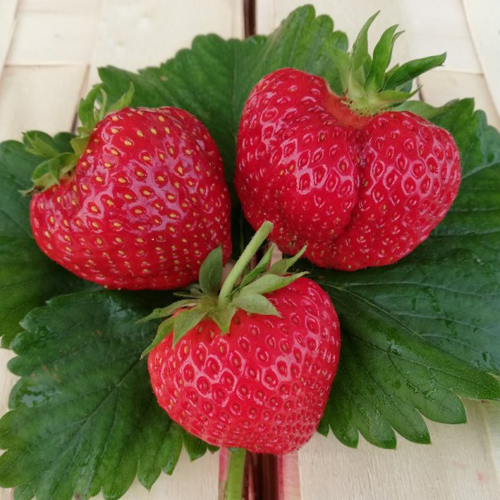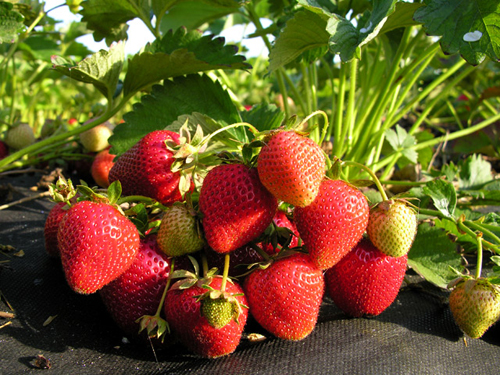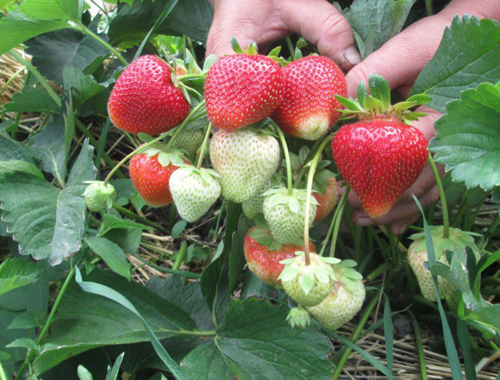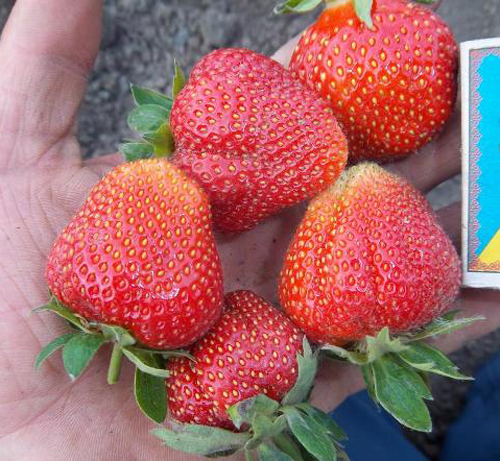Strawberry variety Marmalade
Marmalade is a non-repairing medium-ripening strawberry variety. Bred by Italian breeders in 1989 by crossing Gorella and Holiday varieties. The official name of the strawberry is Marmolada Onebor, popularly called Marmolada. Zoned for the mild climate of Italy, can be successfully grown in Central Russia, Forest-steppe and southern regions, as well as in the south-east of Ukraine and Belarus. It is appreciated for its large fruit size, excellent taste of berries and their excellent appearance, high yield. The variety is more suitable for growing in personal plots, however, when cultivated in closed ground, it is very promising for commercial use.

The plant is tall, powerful, medium spreading, and quite compact - Marmalade can be grown with compacted plantings. Leaves are medium-sized, raised, dark green in color. Abundant formation. The flowers are rather large, directed upwards, located above the level of the leaves. Intense flowering, many fruits are tied. Strawberries form a large number of peduncles, which ensures good yields. The peduncles themselves are strong, hold fruits well, and are not prone to lodging under their weight.

Fruit jelly berries are large, have a rounded-conical shape, especially large specimens are often comb-shaped and corrugated ("accordion"). The tip of the fruit can be either pointed or slightly flattened. In general, the variety does not differ in the uniformity of the shape of the berries, but this will not be a big problem when selling strawberries on the market. The sepal is raised, bright green in color. The skin is bright red, shiny. Achenes are yellow, not deeply pressed into the pulp, practically invisible when consumed. At the stage of technical ripeness, the fruits are not completely colored - they have a light green tip. When fully ripe, the berries acquire a solid dark red color, but in this form they are no longer suitable for transportation, they become too soft, but their taste is much richer than that of immature ones.

The strawberry pulp is red, juicy, moderately dense, has a pronounced strawberry aroma. The taste of the variety is multifaceted, sweet with barely noticeable sourness, perfectly balanced, with a pleasant slightly spicy aftertaste. However, it should be said that the reviews of gardeners about the taste of Marmalade are very contradictory. Someone calls the taste of berries mediocre, someone admires them, and someone refers to the rank of "mediocre" - good strawberries, but sometimes it is sweeter, but more interesting. In a word, it is difficult to understand whose opinion is close to reality, so you just need to conduct a personal tasting. By the way, the weather conditions of the season and the cultivation technique greatly affect the taste.

Berries are universal in use, but their main area of application is processing. They are suitable for a wide variety of culinary dishes, perfectly suited for canning, freezing, and excellent in dried form. According to some reports, strawberry pulp has an increased gelling ability, hence the name of the variety. Fruits at the stage of technical ripeness tolerate transportation well, but in this regard, our heroine is noticeably inferior to other commercial varieties, the "giants" of the strawberry market. Fully ripe berries are not particularly suitable for transportation - they are too soft, easily crumple and release juice, without losing their presentation, they can survive transportation only from the garden to the mouth, or to the kitchen. It should be noted that Marmalade is not declared as hard-fruited, and one should not complain about the insufficient density of its berries.

The variety is distinguished by uniformity of fruits and stability of fruiting - the berries do not shrink by the end of the season. Their average weight is noted at the level of 20-25 grams, and larger specimens with a weight of 30-40 grams are not uncommon.However, it should be noted that the largest berries are often comb-shaped. The strawberry yield is high - from 700 grams to 1.5 kg per plant, depending on the cultivation technology. The best results Marmalade shows in closed ground, when creating optimal conditions for it and sufficient feeding. Thus, when planting 40-41 thousand bushes per hectare of area, it is possible to collect about 12.5-15 t / ha. And these are very good numbers, but without proper care it will be very difficult to achieve them.

Strawberries are resistant to verticillary wilt, susceptible to white and brown spots. In general, over the years of "trials" in various conditions, our heroine was struck by diseases no more often than other varieties. Thus, the resistance to major diseases can be said to be relatively good. Nevertheless, it is highly advisable to observe preventive measures. Winter hardiness, like frost resistance, in plants is very weak. The fact is that Marmalade was originally bred for cultivation in regions with a warm mild climate, and it is simply unable to withstand the harsh conditions of some regions of Russia. Of course, a good shelter for the winter and the use of covering materials in the spring will solve the problem in order to avoid the harmful effects of return frosts. In general, in regions unsuitable for the species, it is better to practice cultivation in closed ground - in greenhouses and hotbeds. By the way, with this method, the plants will begin to bear fruit a week or two earlier.
But our heroine can only boast of drought resistance. Strawberries easily tolerate heat, berries are not baked in the sun, and dry periods do not adversely affect plants. However, with a lack of moisture, the fruits become less juicy, and besides, they become smaller, and voids can also form inside the pulp. Thus, it is still best not to forget to regularly water the plantings. The best option is to install a drip irrigation system.
Marmalade is very demanding on the composition of soils, prefers neutral-acidic soils with a pH of 6.5-7. Although he rather does not even prefer, but demands - not in every area strawberries will show good results, and in some they will not take root at all. In leaving, she is also quite whimsical - it will not work to plant and forget. On the other hand, there is nothing supernatural in the cultivation technique of the variety, so we will consider only the most basic nuances.
- Planting is carried out according to the scheme 25-30 × 50 cm. For mother plants, the area is slightly expanded - 45-50 × 60-70 cm. Before planting, the soil must be properly prepared and fertilized. It is very important to provide the plants with the necessary nutrition from the very first days.
- Before planting, it is highly recommended to treat the seedlings in an antifungal solution.
- Do not forget about watering and, of course, feeding. As befits a commercial variety, the yield of Marmalade is directly proportional to the quantity and quality of food. In short, the more generously you feed the strawberries, the richer the harvest you will get. Of course, you shouldn't overfeed your plants. Organic matter is introduced before planting and until flowering, then mainly mineral complexes are used.
- Rejuvenate the plantation in a timely manner. The plant reaches its peak productivity in the second year of fruiting, then the yield decreases. Thus, a simple gardener should replace the planting material for 3-4 years of use. For farmers, it will be more expedient to grow this variety in a one-year culture, maximum two-year, but no more.
It's time to take stock. This strawberry is very popular with large agricultural firms in Europe and is no less known to gardeners and farmers in Russia, Ukraine and Belarus.It is high-yielding, has beautiful marketable berries with good taste, good transportability. But in return for all its advantages, it requires very painstaking care. In short, without dancing with a tambourine, especially in unsuitable regions when grown outdoors, it will be quite difficult to get good results. Still, in commercial terms, Marmalade justifies its declared characteristics only when cultivated in closed ground with a full range of agrotechnical measures, including abundant feeding and processing with chemicals. And, in truth, for an ordinary gardener, this strawberry is not particularly attractive - it requires too much, tends to be capricious, and in return gives a good yield, but not the most delicious berries. According to numerous reviews of gardeners, it is better for yourself to choose a different variety, with brighter taste and less whims.
Another very big drawback of the variety is its poor adaptation to regions with a harsh climate. In short, Marmalade is a very controversial strawberry. Who knows, maybe it will show record results on your site. In any case, you definitely can't call it bad, and planting a couple of bushes, at least for the sake of an experiment, is definitely worth it. And then it will become clear how tasty it is and how much it justifies all the work invested in its cultivation.









I have been growing this variety for only two seasons, so there is still no full impression of it, only some observations. The taste really corresponds to the name - the berry is very sweet with a pleasant, slightly nutmeg hue - it seemed to me so. The appearance is also good - elastic, beautiful shade, with a glossy surface. For the combination of taste and appearance, I would recommend this variety as a table variety. In the first year, of course, I did not expect yields - I planted only 5 one-horned bushes - but by the end of summer they gave out so many mustaches that they filled almost the entire garden of 1.5 × 3 m. In the second year, some of the flowers suffered from recurrent frosts, so the yield of a special variety did not please me - I will continue to test it.